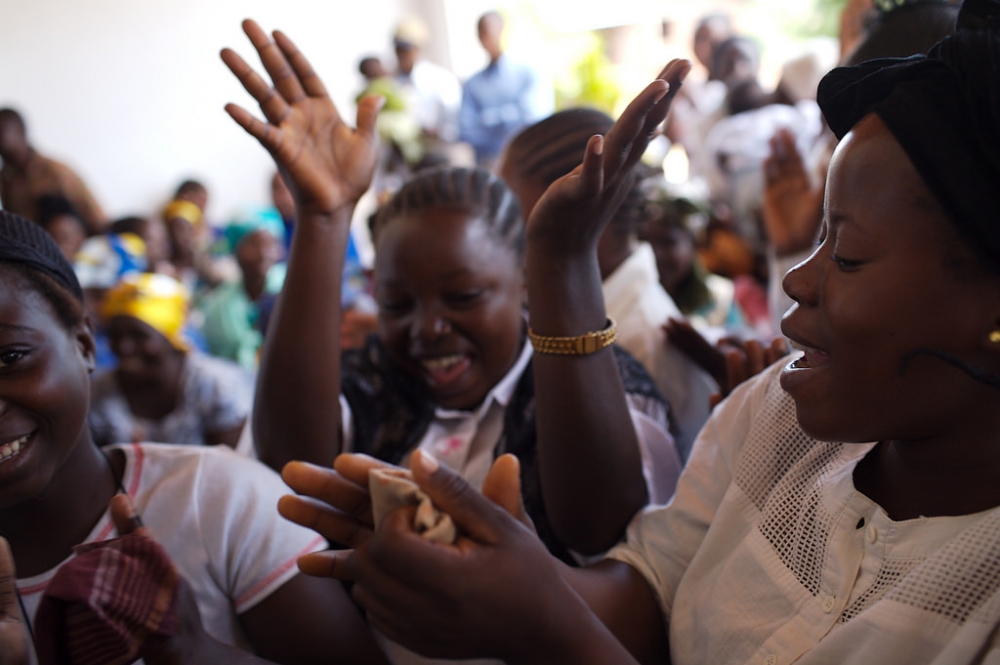It Is Time to End the Child Soldier Stereotype
MILITARISM, 12 Feb 2018
Tim Molyneux | IRIN – TRANSCEND Media Service
Monday, February 12th marks the International Day against the Use of Child Soldiers, known as Red Hand Day.
From Syria and the Democratic Republic of Congo to Myanmar and Nigeria, countless children remain trapped in armed conflict.
9 Feb 2018 – The UN Secretary General’s 2017 Report on Children and Armed Conflict names 56 non-state armed groups and seven state armed forces in 14 countries that recruit children.
Escalating conflicts have led to a spike in child recruitment in several regions. Deepening unrest in Congo saw more than 3,000 child soldiers recruited in 2017, levels in the Middle East have doubled, while the shocking scale of recruitment in South Sudan was laid bare again this month by Human Rights Watch.
“In conflicts around the world, children have become frontline targets, used as human shields, killed, maimed and recruited to fight. Rape, forced marriage, abduction and enslavement have become standard tactics,” a UNICEF statement declared in December.
Child soldier myths
Sadly, the use of child soldiers is nothing new, but the recent spotlight placed on Nigeria’s “Chibok girls” and the “Caliphate Cubs” of so-called Islamic State has drawn global attention to the problem.
The abduction of the 276 schoolgirls from the Nigerian town of Chibok by Boko Haram militants in 2014 raised awareness of the harsh reality faced by girls in some armed groups – from sexual abuse to their increasing use as suicide bombers.
The brutal indoctrination of children recruited to fight under IS, and their prominent use in propaganda materials, illustrates both the vulnerability of children and the lengths some armed groups will go to exploit them.
Child soldiers have always played many roles during armed conflict, as porters and cooks, messengers or spies, while sexual, physical, and psychological abuse is also common. Many are kept away from the front lines.
But child soldiers are still too often reduced to stereotypes. A Google search of “child soldier” shows children bearing arms in all but four of the first 50 images, and 47 of them are boys.
The UN estimates up to 40 percent of child soldiers worldwide are in fact girls, who often encounter serious difficulties when returning home.
Another misconception is that once they are freed from an armed group, former child soldiers will return to a normal life and be welcomed with open arms by their communities.
In reality, rejection and discrimination by family and friends is commonplace. Child Soldiers International conducted research in Congo in 2016 that brought to light the hardships endured by returning girl soldiers.
Of 150 girls interviewed, a majority had suffered horrendous sexual abuse, with several taken as “wives” by their captors. Their experiences were compounded when they returned home, as many were ostracised by their families.
Practical support
This is one reason why global efforts to improve the reintegration of child soldiers must intensify, and should be tailored to local environments and the individual needs of children.
For example, we found that the overriding wish of the girls in Congo was to return to education, to help them take on a positive identity and achieve redemption in the eyes of the community. Involvement in agricultural initiatives – the most common source of occupation in eastern Congo – also helped significantly, as well as bringing positive benefits to the broader community.
We also found that engaging community leaders to involve the girls in social activities helped strengthen relationships and change the way family and friends viewed them.
Upholding rights, providing funds
To ensure that reintegration support for these children is effective, there needs to be a more concerted effort to back appropriate programmes.
According to a recent report, while total Official Development Assistance amounted to $174 billion in 2015, only 0.6 percent was spent on projects fully or partially designed to end violence against children.
It is crucial the international community recognises the importance of reintegration, and while many programmes provide low-cost, community-based solutions, significant financial support must be sustained.
For monetary assistance to have any impact, governments must uphold the rights of returning children. However, the UN has raised concerns that children leaving armed groups are increasingly treated as threats rather than victims, and many face detention and ill-treatment.
“Many children are detained on the basis of groundless suspicion, flimsy evidence, or broad security sweeps,” a 2016 HRW report said. “They are often denied access to lawyers and relatives, and the opportunity to challenge the basis of their detention before a judge.”
As victims of grave human rights abuses, children should never be punished solely for being associated with an armed group. Governments should prioritise their release and reintegration, and hold those who recruit them to account.
Progress
Undoubtedly, great steps forward have been taken. Since 2000, UN engagement has led to the release of more than 115,000 children from the ranks of armed forces and armed groups, and the UN has signed 29 agreements with warring parties to protect child rights.
This International Day against the Use of Child Soldiers, on Monday, also marks 18 years since the adoption of the international treaty created to prevent the use of child soldiers.
To date, 167 countries have ratified the treaty, with Central African Republic the most recent signatory in September 2017.
With the recruitment and use of child soldiers showing little sign of abating, the international community must recognise the acute impact of this heinous practice. But while it is vital they continue to press for their release in the short-term, governments also need to ensure that children have the long-term, practical support they need to reclaim their childhood.
_________________________________________________
 Tim Molyneux – Programme manager at Child Soldiers International, which works to end the recruitment of children.
Tim Molyneux – Programme manager at Child Soldiers International, which works to end the recruitment of children.
 IRIN delivers unique, authoritative and independent reporting from the frontlines of crises to inspire and produce a more effective humanitarian response. After 19 years of award-winning humanitarian news and analysis, IRIN, originally the “Integrated Regional Information Networks“, left the United Nations in January 2015 to relaunch as an independent, non-profit media venture. We have been providing ground reporting on humanitarian crises in a way nearly no other institution does. Outside the UN, we are even better positioned to play this critical role, drawing on the expertise, networks and credibility we have developed, and combining them with increased reach, a more innovative approach and a sharper voice.
IRIN delivers unique, authoritative and independent reporting from the frontlines of crises to inspire and produce a more effective humanitarian response. After 19 years of award-winning humanitarian news and analysis, IRIN, originally the “Integrated Regional Information Networks“, left the United Nations in January 2015 to relaunch as an independent, non-profit media venture. We have been providing ground reporting on humanitarian crises in a way nearly no other institution does. Outside the UN, we are even better positioned to play this critical role, drawing on the expertise, networks and credibility we have developed, and combining them with increased reach, a more innovative approach and a sharper voice.
DISCLAIMER: The statements, views and opinions expressed in pieces republished here are solely those of the authors and do not necessarily represent those of TMS. In accordance with title 17 U.S.C. section 107, this material is distributed without profit to those who have expressed a prior interest in receiving the included information for research and educational purposes. TMS has no affiliation whatsoever with the originator of this article nor is TMS endorsed or sponsored by the originator. “GO TO ORIGINAL” links are provided as a convenience to our readers and allow for verification of authenticity. However, as originating pages are often updated by their originating host sites, the versions posted may not match the versions our readers view when clicking the “GO TO ORIGINAL” links. This site contains copyrighted material the use of which has not always been specifically authorized by the copyright owner. We are making such material available in our efforts to advance understanding of environmental, political, human rights, economic, democracy, scientific, and social justice issues, etc. We believe this constitutes a ‘fair use’ of any such copyrighted material as provided for in section 107 of the US Copyright Law. In accordance with Title 17 U.S.C. Section 107, the material on this site is distributed without profit to those who have expressed a prior interest in receiving the included information for research and educational purposes. For more information go to: http://www.law.cornell.edu/uscode/17/107.shtml. If you wish to use copyrighted material from this site for purposes of your own that go beyond ‘fair use’, you must obtain permission from the copyright owner.
